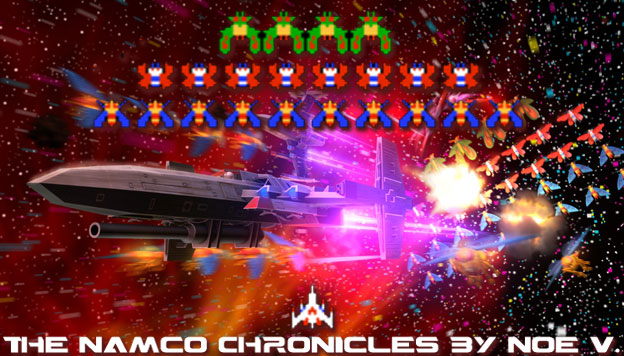
The decade of the 1980's was always compared to the wild west for the video game industry. It was a period where a tremendous fortune could be made by a single hit or lost on a terrible gamble. The smallest companies, like Microsoft and Apple, would come out of nowhere and become giants. Companies that had always been invested in the electronic entertainment business, like Sega, Williams and Midway had moved their operations away from mechanical and electro mechanical pinball and arcade boxes into all-electronic video cabinets. Atari was a relatively young upstart but was one of the companies that was poised to become a giant by the end of the '70s. Their operations were bolstered when they began distributing Namco games in the USA. A string of hits, not the least of which was Pac-Man, insured that the company would be able to to push their R&D department as far as they could.

I gave Namco a lot of credit for setting the foundations of the SHMUP in the previous blog. To be fair the US had contributed a tremendous amount to the genre as well. The 1979 Atari game
Lunar Lander was special to me and would set the precedence for simulation-style experiences from the company. Yet that was not the vector-graphics based game I was referring to. In 1980 the Williams Electronics company
released a game called Defender. It was a frenetic race to save humans from the clutches of alien abductors. Gamers could pilot a space jet and shoot down UFOs and carry humans to safety. The vector graphics were in full-color and appeared even better rendered than those from Missile Command. The game was notable for its lightning quick gameplay, use of a map at the top of the screen and brilliant special effects. The side-to-side scrolling display was different than the top-down scrolling that had been featured in Space Invaders and Galaxian. Many of the longest-running SHMUPS, like Darius, Gradius and R-Type had gone from left to right rather than top down. This game predated them all by at least half a decade.
Sega was getting hammered by their rivals in the science fiction shooter category. The studio wanted to show that they were serious contenders so they secured a very popular license from the west. The Star Trek: Strategic Space Simulator appeared in 1983. I remember seeing the deluxe sit down cabinet in the arcade one weekend. It looked as futuristic as the sets featured in the live-action film. I was a kid when the film came out so I didn't really understand it but thought it looked impressive. The graphics were minimal on the clean-white pressboard cabinet. It was supposed to look and feel like the captain's chair. It had a tinted window the player and even canopy which added a sense of privacy and a bit of designer appeal.. The controls were on the armrests rather than under the screen. Players used buttons and a rotary knob to control the ship, its weapons and acceleration.
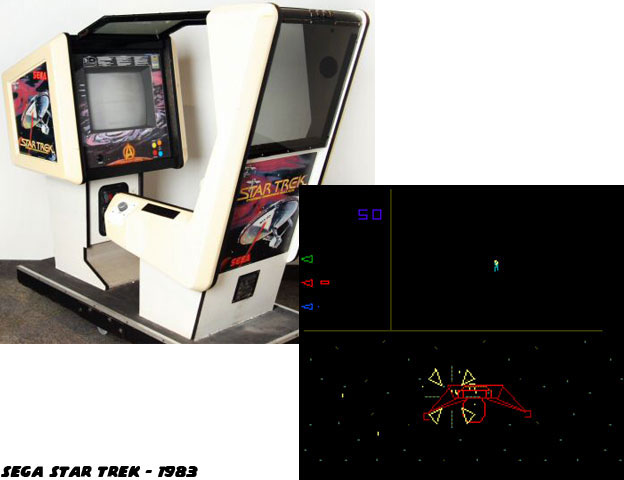
The audio clips from Spock and other Starfleet Characters were very futuristic for the time. The game
looked and played like an advanced version of Asteroids. Granted it was nice being able to try out the Phasers, Photon Torpedoes and Warp in a video game but the experience felt flat. Possibly because the game was set on a two-dimensional plane and you had a better chance of staying alive if you used the smaller map (the one that looked like Asteroids) on the top right corner to track your ship rather than the large portion of the screen which was reserved for 3D vector models of enemy space ships. It got limited play at my local arcade possibly because it focused too much on the simulator experience and less on the gameplay experience. It was difficult to control and the different weapons systems weren't intuitive. The secret to great arcade experiences was something that a player could pick up quickly yet take a long time to master. I don't remember seeing the Star Trek game in many arcades, at least not a working copy, so I was lucky to have gotten a chance to play it while it was out.

The same year that Sega had released an expensive flop Atari had put themselves back on the map. The US company had secured the only license that was even more high profile than Star Trek. Any kid that grew up in an arcade during the '80s could tell you where they were when the Star Wars game came out. Atari had grown by leaps and bounds in the vector graphics department. Three-dimensional shapes were now possible to draw on the fly. Although they were hollow vectors the framework for what would eventually become the polygon had been established. The game came out in both a stand up and deluxe sit-down configuration but if you were like me you waited to play the sit down one. The cabinet was a work of art. Enormous vinyl stickers depicting battles between X-Wing and TIE Fighters decorated the cabinet. It was much nicer to look at than the sterile Star Trek cabinet even if it was a bit reminiscent of the same art featured on the curtains in my bedroom. The controls were also covered in stickers, designed to make the front panel look like the cockpit of an X-Wing fighter. Imagine how impressive this assembly of plastic and plywood looked like to a kid. If our imagination could be set afire by a cardboard box and some colored markers then an arcade cabinet of this caliber was as good as sitting inside of an actual spacecraft.
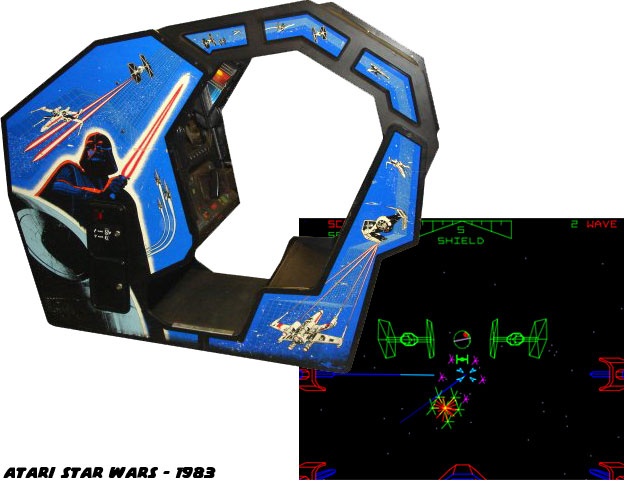
The Empire Strikes back had been released just a few years prior so Star Wars was very much on our mind. In fact to get audiences ready for the sequel most theaters were running the original release again. It was the second showing or Star Wars that I remember slightly more clearly than the original. The screams of the TIE fighters. the enormous Death Star and the pivotal moment in the trench were all recreated by Atari. Using sound clips and digital versions of the John Williams score helped connect the movie experience to the game. Players assumed the role of Luke Skywalker and could actually fight through the battles again and again. The X-Wing was equipped with a set of shields which allowed you to survive several hits from an opponent, which was something that was much more forgiving than the Japanese games. It seemed like if you got hit once in those games you were dead. Every destruction of the Death Star made the game just a bit harder and more frenetic but even then audiences kept coming back to try and beat their own high score.
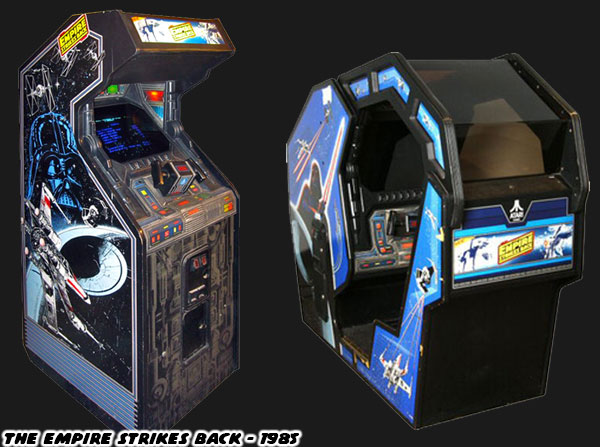
In 1985
Atari released the Empire Strikes Back in the arcade. The game was only marginally better than the original Star Wars and failed to draw in the numbers that they had achieved previously. What was odd however was that Atari had released
the Return of the Jedi in 1984. The film ROTJ had appeared in 1983 so Atari needed to get a title out right away. In the process they seemed to cut a lot of corners and defaulted back to sprite based graphics. The game was very simplistic, almost kiddy-ish in its approach to the genre. It was an isometric game that lacked the charm of the previous vector entry. Not only that but Atari was selling both the Empire Strikes Back and the Return of the Jedi as upgrade kits to their existing cabinet. Arcade operators only needed to change a few components and a marquee and let the audiences use the same yoke setup to get through the games.
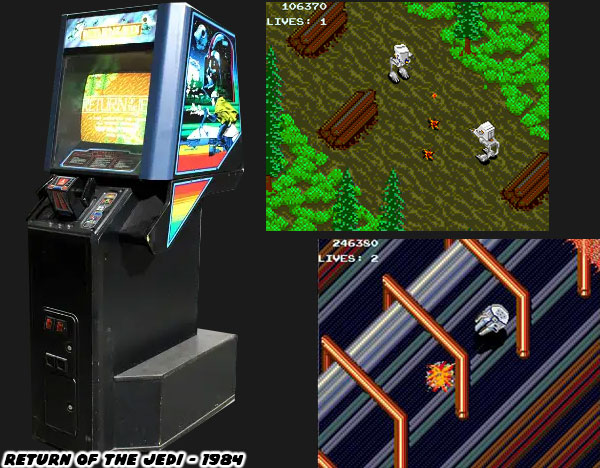
I played the sequels a few times but nowhere as much as I had the original version. It would take a decade for Atari's version of Star Wars to be topped. Sega capitalized on the decline of Atari in the arcade and snatched up the license. They created
an impeccable experience in 1993. This time it featured actual polygons instead of hollow vector frames. Many of the film characters had digitized appearances and sound clips in the game. The title was also a two-player experience with one person acting as the pilot and the second as a gunner. The game still played out on a path, or a track, but the pilot still had a little bit of leeway while flying around. Sadly very few people in the US got a chance to play the game. Even in all of the arcades that I visited in the southland I was only able to find one copy of it. Making it an extremely rare treat when I did play it.
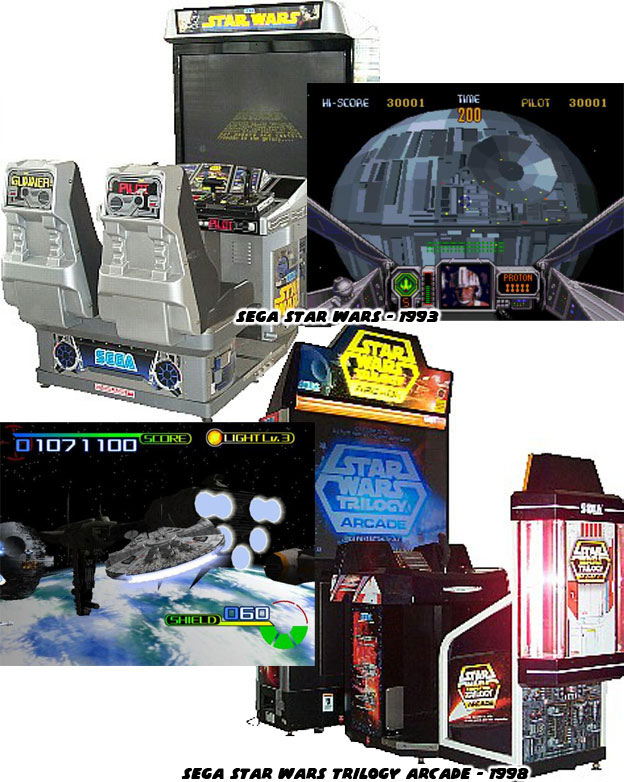
A few years later Sega released what could be considered the definitive Star Wars experience, that was not called Star Tours. The
Star Wars Trilogy Arcade game was sublime. It captured the spirit of every film in relatively short stages. The cabinet and joystick were inspired designs. The controller was a joystick that also served as a gun for the first-person shooting portions of the game, a yoke for the flying portions of the game and even as the handle of a lightsaber during the hand-to-hand combat portions. It featured more digitized audio from the films including the most accurate recreations of the blaster sounds and various film effects ever committed to a game. Sadly by 1998 the arcade industry was in decline and even the most stunning Star Wars experience was not enough to get people out of their homes. PC titles such as Star Wars: Rogue Squadron and Wing Commander provided an immersive space combat experience as well.
If you would like to sponsor me
please visit my Patreon page and consider donating each month, even as little as $1 would help make better blogs and even podcasts!








No comments:
Post a Comment